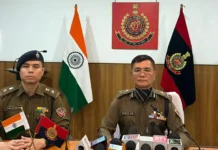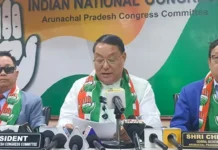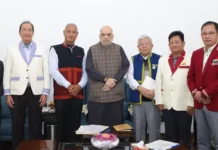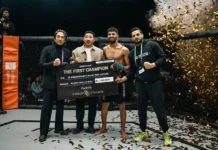[ AN Mohammed ]
Chief Minister Pema Khandu recently termed hydropower one of the most effective sources of revenue generation as Arunachal Pradesh alone holds 50 percent of India’s total hydropower generation capacity. While informing about the increase in revenue collection by the state exchequer, he said it is slated for a massive upward trend in the coming years. Khandu informed that the central government has agreed to give 26 percent equity share from each project to the state, besides the existing quota of 12 percent free power. He said that if the proposed 35,000 mw is monetised in terms of revenue gained by the state in the next 10 years, it would be an astounding Rs 10,000 crores per year. “The more revenue we generate, the more we can uplift the living conditions of our people,” he said. (The Arunachal Times, 3 December, 2024).
Arunachal became a state on 20 February, 1987 and thus the state is a late starter in the development process. Planning for hydropower development in the state started in 1983 when the master plans prepared by the Brahmaputra Board, constituted by the government of India for water resources management of Northeast India, identified several storage dams in the Brahmaputra basin primarily for storage of flood with hydroelectric power generation. Proposals for 20,000 mw Dihang (Siang) multipurpose project near Pasighat and 4,800 mw Subansiri multipurpose project near Gerukamukh on the Assam-Arunachal border were cleared for implementation in 1983. The mega projects could not see the light of the day at that time due to lack of investment clearance. In due course of time Arunachal opposed the projects over submergence of its vast areas of agriculture, forest lands along with villages and townships. Hence,instead of one major project, 3-4 smaller cascaded projects were identified in each tributary to reduce submergence.
In 1987, the hydroelectric potential of India, assessed by the Central Electricity Authority (CEA) was1,48,701 mw, out of which 1,45,320 mw capacity was from schemes having capacity above 25 mw. Arunachal is a land of mountains, forests and rivers inhabited by tribal people, and the mountainous topography of the state presents an ideal condition for the development of hydroelectric projects. Arunachal has 50,064 mw potential, out of which only 1,115 mw has been harnessed and 4,880 mw are under development, leaving 88 percent unexploited as on October 2024.
In 1995, three cascaded projects of 2,000 mw Subansiri upper, 1,800 mw Subansiri middle and 2,000 mw Subansiri lower hydroelectric projects were planned on the Subansiri river and 2,700 mw Lower Siang, 1,000 mw middle Siang and 6,000 mw Stage I and 3,750 mw Stage II Upper Siang hydroelectric projects were planned on the Siang river.
The government of India approved the hydropower development policy in August 1998. The object of the policy was to prevent a decline in hydro share and to undertake measures for the exploitation of vast hydroelectric potential in the country, especially in the north and the northeastern regions. Hydro stations at that time accounted for only 25 percent of the total installed capacity as against the ideal hydro thermal mix of 40:60. Besides, strengthening the role of PSUs/SEBs for taking up new hydel projects and increasing private investments were also objectives of the policy. In 2003, the ministry of power launched the prime minister’s 50,000 mw hydropower initiatives and identified 89 projects with more than 50 percent share in Arunachal.
During 2005-2010, in accordance with the national hydropower policy, Arunachal allotted total 140 schemes to central, state and private sectors with total installed capacity of 41,500 mw to be developed on various rivers, rivulets and streams on seven major river basins, namely Tawang, Kameng, Dikrong, Subansiri, Siang, Dibang and Lohit. Fifty projects were less than 25 mw, 50 projects were of the capacity between 25 to 100 mw and 28 projects were more than 500 mw (mega projects).
Factors impeding private developers in hydropower
Out of a total potential of 50,064 mw in Arunachal, only three hydroelectric projects – 405 mw Ranganadi (2001), 110 mw Pare (2019) and 600 mw Kameng (2020) – have been developed by the NEEPCO,totalling 1,115 mw (2.23 percent). The 2,000 mw Subansiri lower hydroelectric project and the 2,880 mw Dibang multipurpose are two mega projects under construction since 2005 and 2023, respectively,by the NHPC.
Many private developers signed memorandums of agreement (MoA) during 2005-2010 in Arunachal for 140 schemes of different capacities, with total installed capacity of 41,500 mw, but could not make headway towards implementation. After huge investments in upfront premiums, investigations for preparation of detailed project reports (DPR) and taking statutory clearances, the private developers compelled to give up.
Private developers faced several challenges in developing hydropower projects.
Infrastructure deficiencies: Most of the hydropower projects being situated in remote inaccessible locations, inadequate infrastructure, such as poor or no road connectivity, health facility and lack of reliable power transmission networks, local law and order issues, etc, added to the challenges.
Regulatory hurdles: Complex regulatory processes, including obtaining environmental, forest clearance and land acquisition process, often led to time and cost overrun, resulting in increased electricity cost making the projects unviable.
Policy uncertainties: Frequent changes in government policies and lack of long-term policy support created an uncertain investment climate. In 2013, when the DPR and environment impact assessment and management reports were either completed or under preparation in respect of most of the projects, cumulative impact assessment and carrying capacity study of the Siang and the Subansiri basins were carried out by the Central Water Commission (CWC). The Siang basin study report stated that the proposed 44 dams of 18,300 mw capacity on the Siang basin would prevent natural flow of a river length of 513 kms and submerge 23,867 hectares of forest land, altering the entire Siang river aquatic system, which would adversely impact the aquatic biodiversity. The report recommended 15 such dams of 473 mw capacity to be dropped. Dam height in some mega dams to be reduced to keep one km river reaches free in between two consecutive proposed reservoirs. The developers strongly objected to such modifications as huge investments and time in preparation of DPRs had been made on basis of elevations of full reservoir level (FRL) and tail water level (TWL) mentioned for each project in the MoA signed with the government Arunachal Pradesh. The gradient of the rivers in Arunachal are so steep that the dam height needed to be reduced to keep one km river reaches free in between two consecutive proposed schemes resulted in drastic reduction in power generation, making the project unviable.
The ministry of environment and forest & climate change (MoEF&CC) had directed for compliance the release of environmental flows, which is 30 percent in monsoon season, 20 percent in lean season and 25 percent in non-monsoon and non-lean season of the natural river flow for sustenance of river ecology in the downstream. The project developers had to redesign the projects to accommodate the environment flow recommended by the CWC which delayed DPR preparations.
In 2012-13, the government directed all developers to accommodate dedicated flood control components in the hydropower projects in Arunachal. This created discontent among the private developers as it took extra time for additional investigations and enhanced the project cost.
Socio-political issues: Resistance from local communities and environmental groups, along with issues related to resettlement and rehabilitation, posed significant obstacles, resulting in time and cost overrun. The opposition to the 2,000 mw Subansiri lower hydroelectric project under construction at Gerukamukh on Arunachal and Assam border was unique for a trans-boundary river in India.
Central PSU, NHPC Ltd, started construction of theproject in January 2005, but had to be stalled since December 2011 due to anti-dam movement in Assam apprehending adverse downstream effects. The dispute had gone to the National Green Tribunal (NGT), where the NHPC submitted that Rs 10 crores per day loss has been incurred due to stoppage of the construction after completion of 50 percent works. Though the construction of the project resumed after overcoming all hurdles in October 2019 after eight years of stoppage, it suffered huge cost overrun. This has major adverse effects on the hydropower projects development in Arunachal. The financial institutions were reluctant for long-term and ‘risky’ investment,making it difficult for private developers to develop large-scale projects.
Due to time overrun, the cost of generation increased,making the projects unviable. These factors combined to make it difficult for private developers to successfully execute hydropower projects during that period and the private developers abandoned the hydro projects in Arunachal.
In 2014, the government of India proposed to bring large hydropower projects under the ambit of renewable energy to avail the concessions and subsidies to bring down the cost of generation and to introduce power purchase obligation for the states’electricity distribution companies. However, such measures to promote hydropower sector was introduced in March 2019. The measures includedlarge hydropower projects (LHPs, ie > 25 mw projects) which were declared as renewable energy source (RES) to avail all the concessions to RES.
Hydropower purchase obligation (HPO) was notified as a separate entity within non-solar renewable purchase obligation (RPO) tariff rationalisation measures for bringing down hydropower tariff budgetary support for flood moderation/storage hydroelectric projects (HEP).
Budgetary support to cost of enabling infrastructure, ie, project roads/bridges at the rate of Rs 1.5 crore per mw for projects upto 200 mw, Rs 1.0 crore per mw for projects above 200 mw.
Global warming and the way forward
Climate change and global warming are the biggest challenge for humankind. Electricity being vital foreconomic growth, energy transition from fossil fuel,which is mostly responsible for carbon emission to green energy, is the topmost priority for the world. India, being a developing country, will have a power requirement of 2,518 billion units in 2030, and to achieve the goal, India will need to increase its install capacity to 700 mw revised to 817 mw. India has set an ambitious goal to have 500 mw of non-fossil fuel energy capacity by 2030 and attaining carbon neutrality by 2070. Solar and wind power being intermittent, hydroelectricity development is crucial for grid stability.
In December 2021, the government of India decided to hand over 29 projects with 32,415 mw concurred by the Central Electricity Authority (CEA) to the central public sector units (CPSU) to enhance significantly the hydropower capacity in the country in the context of the energy transition goals set for the country. The Centre and the state have come together to rejuvenate and execute 12 stalled hydroelectric power projects with cumulative installed capacity of about 11,517 mw and allotted to central PSUs, viz, NHPC, NEEPCO, SJVN and THDC.
Memorandums of agreement were signed in Itanagar in August 2023 for the projects 186 mw Tato-I, 700mw Tato-II, 240 mw Heo, 1,000 mw Naying, and 500mw Hirong in Siyom Sub-basin with NEEPCO; 3,097 mw Etalin, 680 mw Attunli, 500 mw Emini, 420 mw Amulin, and 400 mw Mihundon in Dibang Basin with SJVN; 2,000 mw Subansiri upper, and 1,800 mw Subansiri middle (Kamala) in Subansiri Basin with the NHPC. 1,200 mw Kalai-IIHE project in Lohit basin was signed in December 2023 with THDC.
Addressing the event, the then union minister for power and new & renewable energy RK Singh said that implementation of these hydropower projects would contribute immensely to the richness of the state. “The per capita income of the state would become more than that of Maharashtra and Gujarat. All the developed nations, including the USA, Canada, Norway etc, have harnessed 80-90 percent of their hydropower potential. In India also, the states which harnessed the potential of hydropower have become prosperous. Hydropower is a green source of energy.”
In August 2024, the Centre approved an initiative to boost hydroelectric power development in the northeastern region. With a central financial assistance of Rs 4,136 crores allocated from FY 2024-25 to FY 2031-32, this scheme would support the development of hydro projects with a cumulative capacity of around 15,000 mw. The grant towards equity portion of the state government of the region would be capped at 24 percent of the total project equity subject to a maximum of Rs 750 crore per project. Arunachal has been directed to form joint ventures (JV) company with the central PSUs with equity participation in respect 13 hydroelectric projects assigned in August and December 2024.
Status quo
Though more than a year has been passed since the allotment, construction for not a single hydro project has been started so far. Despite acceptance of the DPRs of the projects approved during 2011-14 which saves long investigation periods, the challenges faced by the CPSUs are,
The environment and forest clearances received during 2011-14 are not accepted by the MoEF&CC and directed CPSUs for fresh studies and approval which need minimum 2 years.
Van (Sanrakshan Evam Samvardhan) Rules, 2023 states that “the user agency shall provide equivalent non-forest land that is not under the management and administrative control of forest department for compensatory afforestation in lieu of forest land proposed for diversion.” Hydropower projects are generally located in the remote and hilly regions where non-forest land is not available. “If non-forest land is not available, compensatory afforestation shall be raised on a degraded notified or unclassed forest land under the management control of the forest department, which is twice in size and the user agency shall also bear the additional cost on such account. The degraded unclassed state forests in the state of Arunachal Pradesh shall be considered for compensatory afforestation, provided they are transferred and mutated inthe name of state forest department.” The onus of providing land for compensatory afforestation prolongs the process of obtaining forest clearances.
Land acquisition process as per Right to Fair Compensation and Transparency in Land Acquisition, Rehabilitation and Resettlement Act, 2013 takes minimum two years. The social impact assessment and management plans during land acquisition process are time consuming and delays the construction of the hydro projects.
Instead of updating, the reiteration of environment impact assessment studies and holding of public consultations as per the Environment Impact Assessment Notification 2006 is delaying the implementation of the hydro projects.
Conclusion
The government of India introduced a single-window clearance cell in June 2023 to expedite the approval process for pumped storage projects (PSP). These initiatives aim to fast-track the clearance of DPRsand reduce the time required for obtaining regulatory clearances, viz, environment, forest, etc. Such initiatives are necessary for development of conventional hydropower projects also.
The efforts put by the government of Arunachal for fast-tracking development of hydropower projects is not adequate for the CPSUs to start construction of the schemes signed 16 months back. More attention is necessary for removing the hurdles of entirely repeating the environment, forest clearances and land acquisition process for the mega projects to start in next one year. The history of hydropower development prompts that delay in implementation invites many fresh hurdles which may make the projects unviable.
The energy generated from hydroelectric projects will not only help in meeting the shortage of power at the national level, reduction in carbon emissions and revenue generations but will also help in creating social and development infrastructures, direct and indirect employment opportunities which would eventually result in opening up of further avenues for development in the remote and under developed State. (AN Mohammed is a consultant in hydropower development in Northeast India.)





